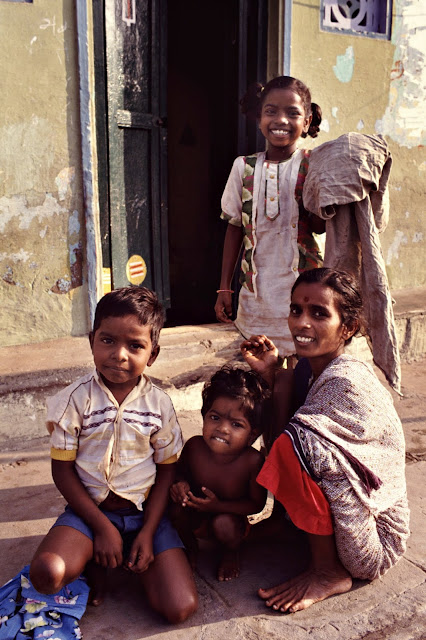 |
| Fisherman's Family, Madras, India |
So how does one go about making
good pictures of people in foreign settings?
It isn't hard if you're prepared.
Here are some basic principles of people photography which have worked
as well for me in African villages as on the streets of London.
First, be organized. Know what you
want to accomplish and plan how you're going to do it. Make decisions about cameras, lenses, and
films before leaving home. Become so
familiar with your equipment that you can use it almost without thinking. Aging eyes and general laziness make zoom
lenses on Canon EOS bodies my mainstay these days, but some of my best people
photos were made with Olympus OM bodies and prime lenses in 24, 35, 85, and
180mm focal lengths.
My camera bag stays at the
hotel, while two bodies with (nowadays) 24-85 and 70-200 lenses go over my
shoulders. Film, caption notebook,
passport, local currency, and a few U.S. one-dollar bills go in a small
belt pouch. I'm light, mobile, and
organized to give full attention to the subject.
It's also essential to be
organized in the way you go about making photographs once you have some kind of
entree with a subject. People in other
countries are can be amazingly gracious and patient, but it's an imposition to
ask them to stand for several minutes while you work them over with a spot
meter and make multiple lens changes.
Both common courtesy and good photographic practice dictate that you
decide about exposure, angles, and focal lengths before approaching the
subject, and then make your photographs in a friendly, businesslike
manner. Before I spoke to the young
craftswoman I had already decided which lenses would be needed, mounted them on
my cameras, and read the light with an incident meter. I was ready to work quickly, fluidly, and
with a confidence that communicated itself to my subject, helping her to be
more at ease and responsive.
Second, be obvious. An American with
a camera in a Guatemalan village marketplace is conspicuous. There's nothing you can do to change
that. Everyone knows you're there, so
don't try to sneak shots. They're
probably more curious about you than you are about them. If you try to hide in the shadows and pick
off shots with a long lens, if you're furtive, if you appear indecisive or
uncertain, you'll be greeted with suspicion.
Accept the fact that you're not going to get fly-on-the-wall candids and
go with the flow. Concentrate on what
you can get. Because if you treat those people with
courtesy and friendliness, chances are you'll be able to make both excellent
photographs and new friends at the same time.
The key is simply to be natural.
Behave as if you have a perfect right to be there and go about your work
in a pleasant, matter-of-fact way.
 |
| Coffee Plantation Worker with His Pet Rabbit, Costa Rica |
Third, be open. Fear is the number one hindrance to good people photography. For that matter, fear of being open and vulnerable is the greatest hindrance in most human relationships. Fear often comes in the form of an inertia which suggests all kinds of reasons why you shouldn't take the picture now. Later will be better. The light will be better. The people will be more receptive. You don't have the right lens. Or the right film. Later...but not now. If you want to make good photographs of people, you must put aside your fear and inertia by an act of your will and begin to photograph -- now. Not later -- now!
What does this have to do with
being open? Everything, because people will not open up to
you until you open yourself up to them.
Put aside your fear of photographing them openly. Project sincere attitudes of friendliness and courtesy. Don't talk any more than necessary. A smile will open more doors than words any
day. These are not aliens from another
galaxy -- they're people, and they will respond to your efforts to relate to
them as people. A smile, an eyebrow
raised in question, a tilt of the camera, a word of greeting in the local
language (if you haven't bothered to learn the words for "hello,"
"please," and "thank you" in their language you shouldn't
even be there) will usually gain the cooperation you need. If not, just smile, say "thank you,"
and move on. My few words of Tamil
spoken to the young woman nearly exhausted my meager vocabulary, but when
combined with an open, friendly approach
they were enough to do the job.
(To be continued)
No comments:
Post a Comment